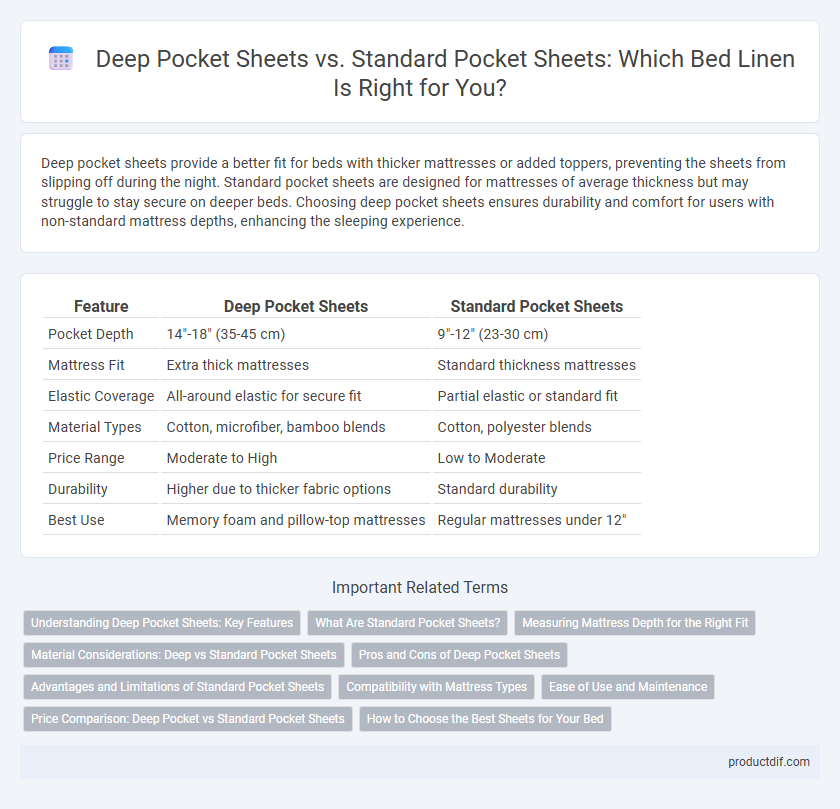Deep pocket sheets provide a better fit for beds with thicker mattresses or added toppers, preventing the sheets from slipping off during the night. Standard pocket sheets are designed for mattresses of average thickness but may struggle to stay secure on deeper beds. Choosing deep pocket sheets ensures durability and comfort for users with non-standard mattress depths, enhancing the sleeping experience.
Table of Comparison
| Feature | Deep Pocket Sheets | Standard Pocket Sheets |
|---|---|---|
| Pocket Depth | 14"-18" (35-45 cm) | 9"-12" (23-30 cm) |
| Mattress Fit | Extra thick mattresses | Standard thickness mattresses |
| Elastic Coverage | All-around elastic for secure fit | Partial elastic or standard fit |
| Material Types | Cotton, microfiber, bamboo blends | Cotton, polyester blends |
| Price Range | Moderate to High | Low to Moderate |
| Durability | Higher due to thicker fabric options | Standard durability |
| Best Use | Memory foam and pillow-top mattresses | Regular mattresses under 12" |
Understanding Deep Pocket Sheets: Key Features
Deep pocket sheets feature pockets typically ranging from 14 to 18 inches deep, designed to fit mattresses with extra thickness, such as those with pillow tops or mattress toppers. These sheets use elastic around the entire perimeter to ensure a snug fit, preventing slipping or bunching during sleep. Their durable construction and stretchable fabric accommodate various mattress depths, providing enhanced comfort and a better overall fit compared to standard pocket sheets.
What Are Standard Pocket Sheets?
Standard pocket sheets typically feature a pocket depth of 14 to 15 inches, designed to fit mattresses up to 12 inches thick. Their elastic corners secure the sheet firmly, but may struggle with thicker mattresses or added pillow toppers. Choosing the right pocket depth ensures a snug fit that prevents slipping and enhances sleep comfort.
Measuring Mattress Depth for the Right Fit
Measuring mattress depth accurately is essential when choosing between deep pocket sheets and standard pocket sheets to ensure a snug, wrinkle-free fit. Deep pocket sheets are designed to accommodate mattresses ranging from 15 to 22 inches in depth, while standard pocket sheets typically fit mattresses up to 14 inches deep. Selecting sheets tailored to your mattress height prevents slipping and enhances overall sleep comfort.
Material Considerations: Deep vs Standard Pocket Sheets
Deep pocket sheets are designed with extra fabric to accommodate thicker mattresses, often requiring durable materials like microfiber or high-thread-count cotton to maintain elasticity and softness. Standard pocket sheets fit mattresses up to 12 inches deep, typically made from cotton blends or percale, which may lack the stretch needed for deeper beds. Choosing between deep and standard pocket sheets depends on mattress depth and material durability to ensure a snug fit and long-lasting comfort.
Pros and Cons of Deep Pocket Sheets
Deep pocket sheets offer superior fit for mattresses thicker than 12 inches, ensuring a snug and secure bedding experience that prevents slipping and bunching, ideal for pillow-top or mattress toppers. The downside of deep pocket sheets lies in the limited compatibility with standard mattresses, potentially causing excess fabric and wrinkles, and often featuring a higher price point due to specialized sizing and materials. These sheets commonly use elasticized corners or full elastic bands to enhance durability and maintain fit, which can lead to quicker wear on elastic components compared to standard pocket sheets.
Advantages and Limitations of Standard Pocket Sheets
Standard pocket sheets typically fit mattress depths up to 12 inches, making them suitable for most traditional mattresses. Their advantages include affordability and widespread availability in various materials and thread counts. Limitations arise with thicker mattresses, where standard pockets may not provide a secure fit, causing sheets to slip off or bunch up during sleep.
Compatibility with Mattress Types
Deep pocket sheets are specifically designed to accommodate thicker mattresses, often ranging from 15 to 22 inches in depth, making them ideal for pillow-top, memory foam, or hybrid mattresses. Standard pocket sheets typically fit mattresses up to 14 inches deep, suitable for most traditional innerspring or basic foam mattresses. Choosing the correct sheet pocket depth ensures a snug fit, preventing slipping and providing enhanced comfort and durability.
Ease of Use and Maintenance
Deep pocket sheets provide a snug fit on thicker mattresses, reducing the need for frequent adjustments and making bed-making easier compared to standard pocket sheets that may slip off more often. Maintenance is simplified with deep pocket sheets as their durable elastic accommodates mattress toppers, ensuring sheets stay secure through washing and drying cycles. Standard pocket sheets, while generally easier to fold, require more frequent repositioning, which can increase wear over time and complicate upkeep.
Price Comparison: Deep Pocket vs Standard Pocket Sheets
Deep pocket sheets typically cost 15% to 30% more than standard pocket sheets due to the extra fabric and reinforced seams required for deeper mattress coverage. Standard pocket sheets are priced competitively for mattresses up to 12 inches deep, while deep pocket options cater to mattresses 14 to 22 inches thick, justifying their higher price point. Investing in deep pocket sheets ensures a secure fit and durability, especially for memory foam or pillow-top mattresses that standard sheets cannot adequately accommodate.
How to Choose the Best Sheets for Your Bed
Deep pocket sheets accommodate mattresses up to 18 inches deep, providing a secure fit without slipping off, while standard pocket sheets typically fit mattresses up to 12 inches deep. Select sheets based on mattress height and fabric preference to ensure comfort and durability; cotton and microfiber are popular for breathability and softness. Measuring your mattress depth before purchasing helps avoid improper fit and maximizes sleep quality.
Deep Pocket Sheets vs Standard Pocket Sheets Infographic

 productdif.com
productdif.com